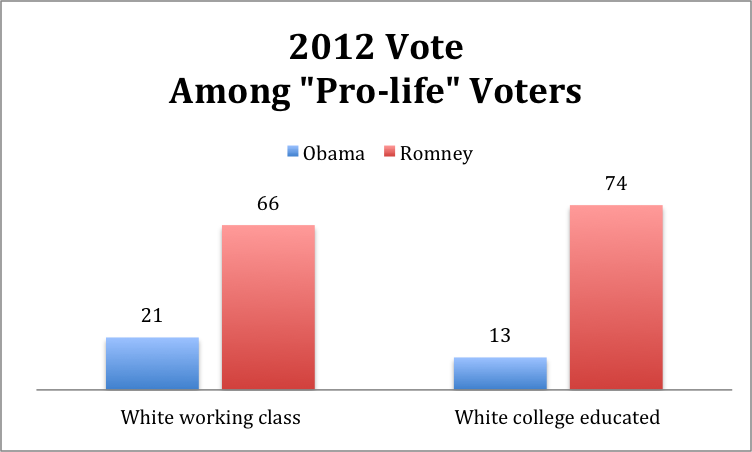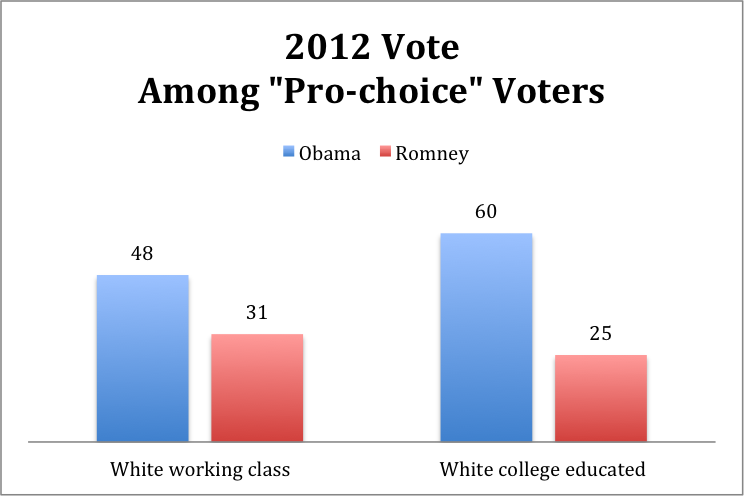Few voters report that the issue of abortion is central to their voting decision, yet abortion has had a significant impact in shaping views of and attachments toward the political parties. (Note: this links to a gated article.) Attitudes about abortion are also highly predictive of presidential vote choice, particularly among white Americans. In recent elections, white Americans who say abortion should be legal in all or most cases have strongly supported Democratic candidates, while those who say it should be illegal tend to have equally strong preferences for the GOP. However, despite the common refrain that white working-class voters are heavily influenced by cultural “wedge” issues like abortion, white college-educated Americans’ vote choice is actually more affected by their stance on this issue.
 Given the increasingly polarized positions the parties have adopted on this issue and the symbolic importance that abortion has taken in our politics, the voting gap among white Americans overall is not surprising. (Note: this links to a gated article.) But appeals to white working-class voters on abortion may be less effective than similar appeals to white college-educated Americans. In the 2012 Race, Class, and Culture Survey, we found that presidential vote choice of white working-class voters was less influenced by abortion than white college-educated voters.
Given the increasingly polarized positions the parties have adopted on this issue and the symbolic importance that abortion has taken in our politics, the voting gap among white Americans overall is not surprising. (Note: this links to a gated article.) But appeals to white working-class voters on abortion may be less effective than similar appeals to white college-educated Americans. In the 2012 Race, Class, and Culture Survey, we found that presidential vote choice of white working-class voters was less influenced by abortion than white college-educated voters.
Among white working-class voters, 66% of those who believe abortion should be illegal supported Romney, compared to 32% of those who believe abortion should be legal. Among white college-educated Americans, 74% of those who believe abortion should be illegal supported Romney, compared to 25% of those who believe abortion should be legal. In other words, the abortion vote gap—the difference in voting preference between those who believe abortion should be illegal and legal—was less pronounced among white working-class voters (a 34-point gap) than among white college-educated voters (a 49-point gap). A similar pattern exists among those who believe abortion should be legal in all or most cases. Fully 6-in-10 (60%) white college educated voters who say abortion should be legal in all or most cases support Obama, compared to less than half (48%) of white-working class voters who support legal abortion.
 What’s more, these voting gaps do not appear to be an artifact of other cultural or demographic differences between these two groups. When holding constant basic demographic, cultural, and political characteristics, views on abortion more strongly predict vote choice among white college-educated voters than among white working-class voters. White college-educated voters who say abortion should be illegal are roughly four times more likely to support Romney than those who say abortion should be legal. Among the white-working class the abortion gap is still significant, but smaller. White working-class voters who say abortion should be illegal are roughly three times more likely to support Romney than those who believe it should be legal.
What’s more, these voting gaps do not appear to be an artifact of other cultural or demographic differences between these two groups. When holding constant basic demographic, cultural, and political characteristics, views on abortion more strongly predict vote choice among white college-educated voters than among white working-class voters. White college-educated voters who say abortion should be illegal are roughly four times more likely to support Romney than those who say abortion should be legal. Among the white-working class the abortion gap is still significant, but smaller. White working-class voters who say abortion should be illegal are roughly three times more likely to support Romney than those who believe it should be legal.
Stereotypes survive because they fit existing narratives, because they are politically useful, and because there is insufficient evidence to contradict them. In our recent report we challenge much of the conventional wisdom about the white working class. The low salience of abortion to white working-class and its more modest impact on vote choice relative to white college-educated Americans should provide evidence to move beyond some of the stereotypes.





